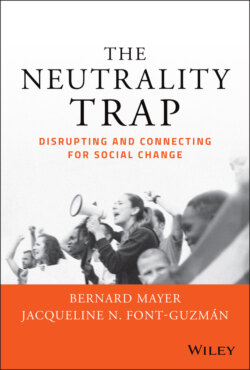Читать книгу The Neutrality Trap - Bernard S. Mayer - Страница 12
Constructive Conflict
ОглавлениеConflict intervention practitioners frequently assert that conflict itself is not the problem, but how we handle it often is. Labor and management struggle over competing interests, environmentalists and fossil fuel producers look at the world through different lenses, and divorcing parents often have different visions and values about rearing children. The challenge we all face, therefore, is not so much how to resolve these differences but how to find a constructive way to deal with them over time.
What conflict interveners have usually meant by handling conflict constructively, however, has been about bringing these differences to rapid and peaceful resolution, tamping down the level of emotionality and particularly anger, “separating the people from the problem,” and minimizing the disruptive effects of conflict on people, communities, and institutions. This vision of what makes conflict constructive negates the true importance of creative and constructive conflict in our world.
So what makes conflict truly constructive?
Constructive conflict moves us forward in creating the world we want to be part of, one that reflects our most important values and desires, promotes the systems that will contribute to the changes we seek, and disrupts those that interfere with these. Constructive conflict is also carried on in accordance with our values about human and group interaction and with the fundamental goals we are pursuing.
There are two important caveats here, however. One is that what is constructive is contextual to the person and situation. The other is that no action is pure. The line between constructive conflict and pointless destruction is often a fine one. When does angry, militant, and effective mass action turn into looting, arson, and violence against individuals?
The initial reaction to the George Floyd murder was justified, necessary, chaotic, and sometimes destructive of the very communities who have been historically victimized by the White racist system that the protests were directed against. This is not unusual. It is what happened after Rodney King was beaten, Dr. King was assassinated, and during some of the most important labor actions in American history (e.g. the Pullman and Homestead Strikes). Accepting that such violence may be an inevitable and sometimes energizing aspect of social change efforts may force many of us to deal with an uncomfortable level of cognitive dissonance, but working for social change requires that we do so. Of course, the violence associated with progressive social movements, although generally small in scale and destruction, is frequently exaggerated and seized upon to discredit these movements in their entirety. This was the response of many supporters of Donald Trump who tried to minimize the destruction and danger posed by the invasion of the US Capitol on January 6, 2021, by equating it with the minor acts of violence that occurred during some Black Lives Matter protests.
The challenge in developing a truly constructive approach to conflict, which of necessity is disruptive, is to move through periods of chaotic disruption to build a multi‐pronged, sustainable, strategic, nonviolent approach to disrupting oppressive systems.
